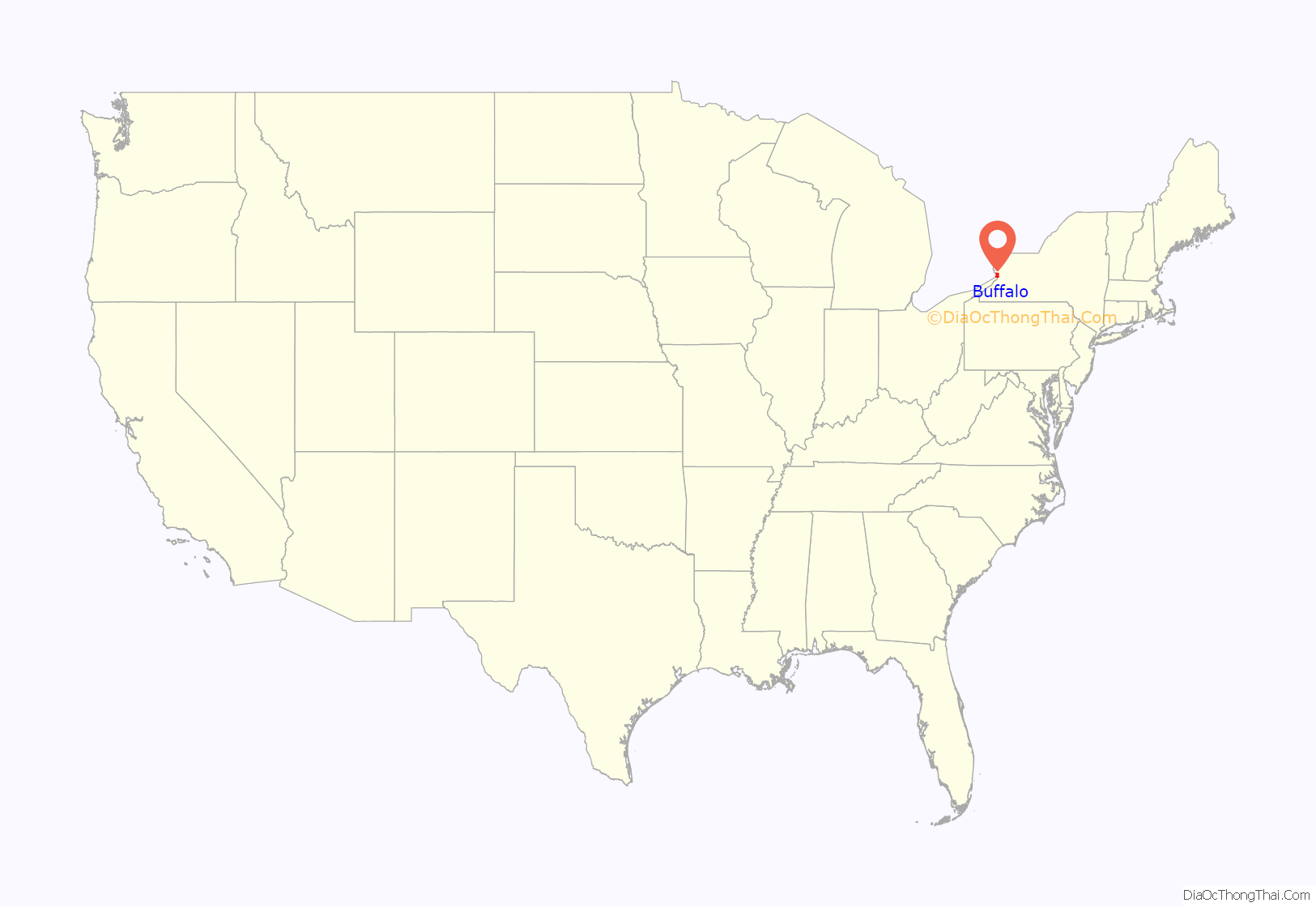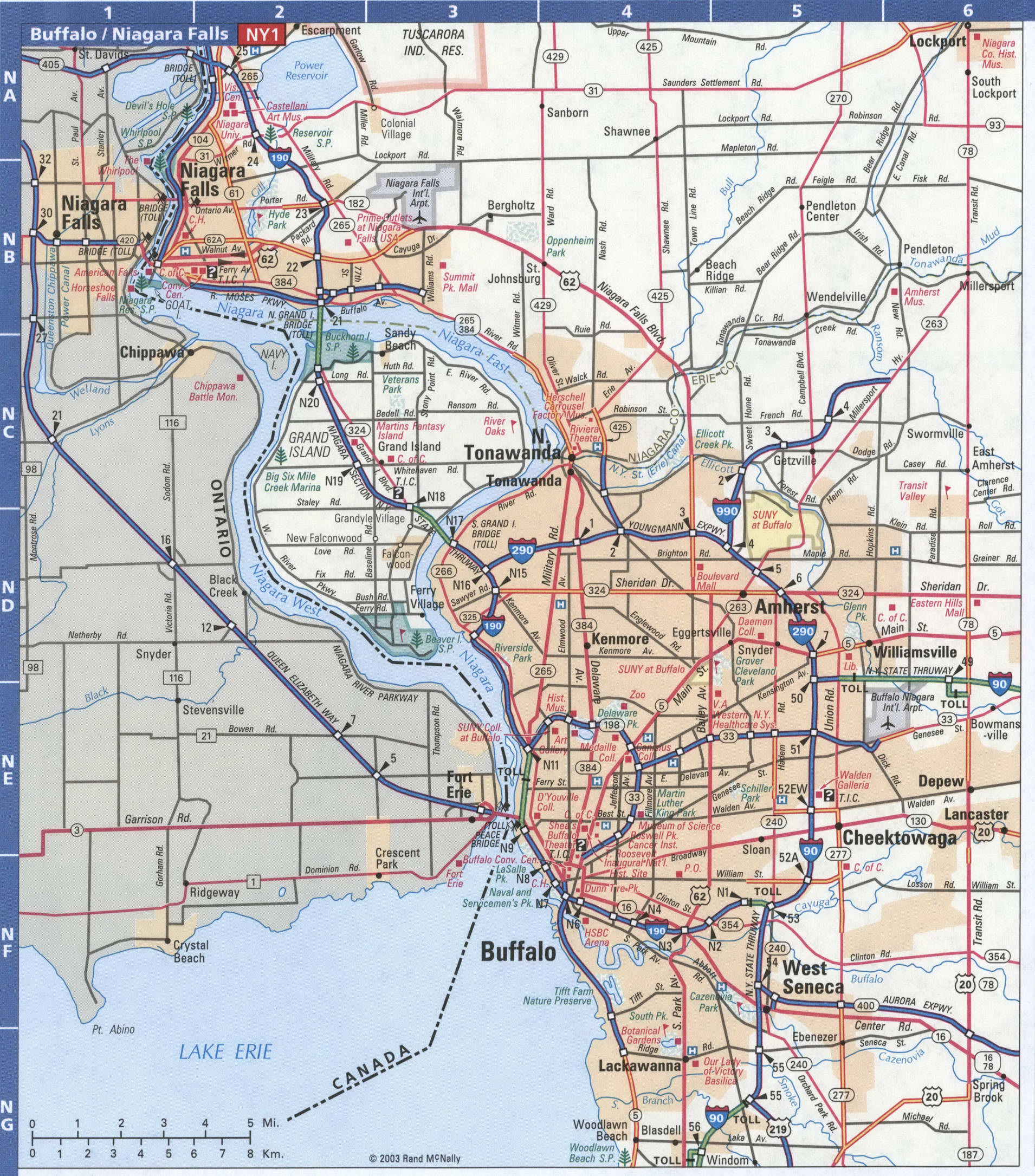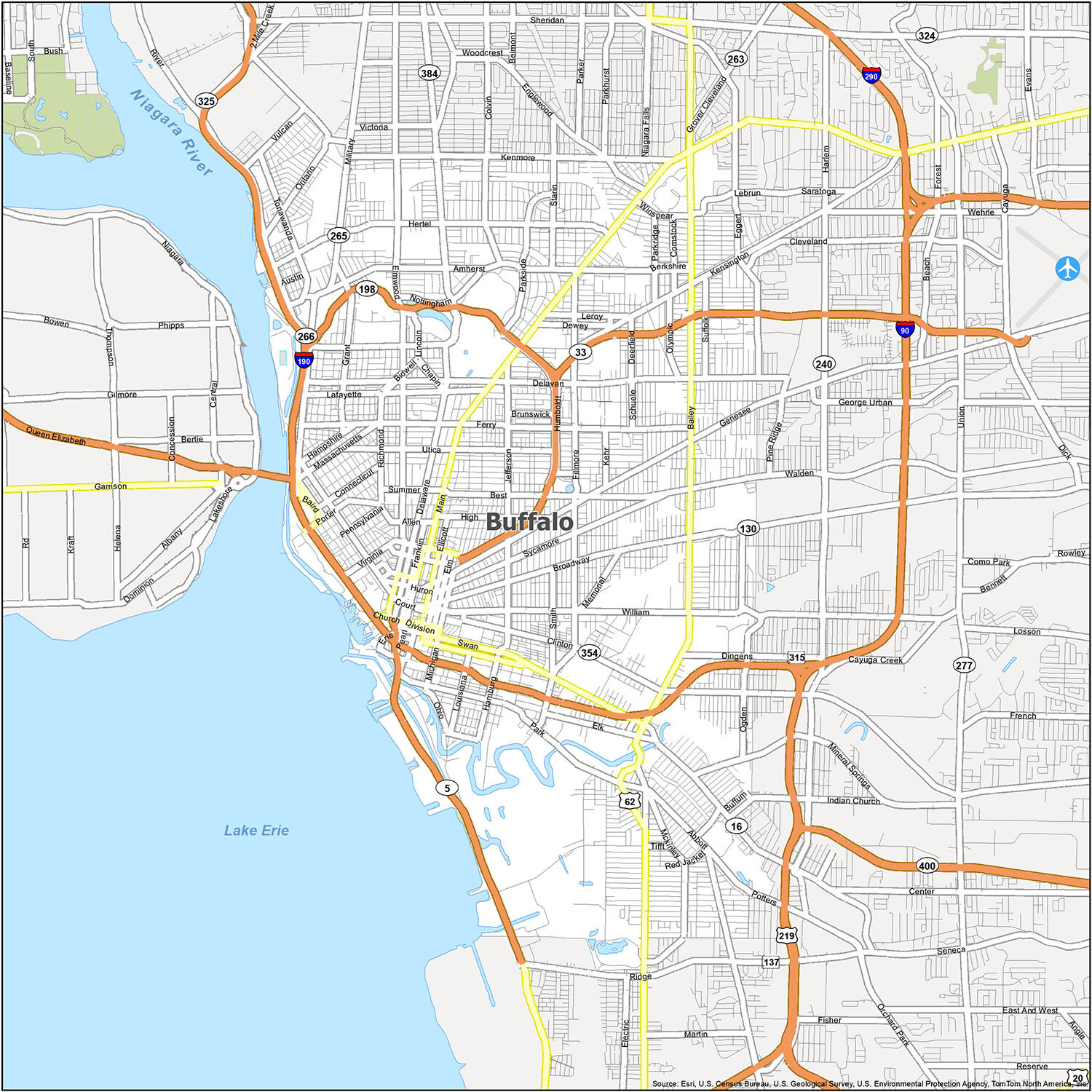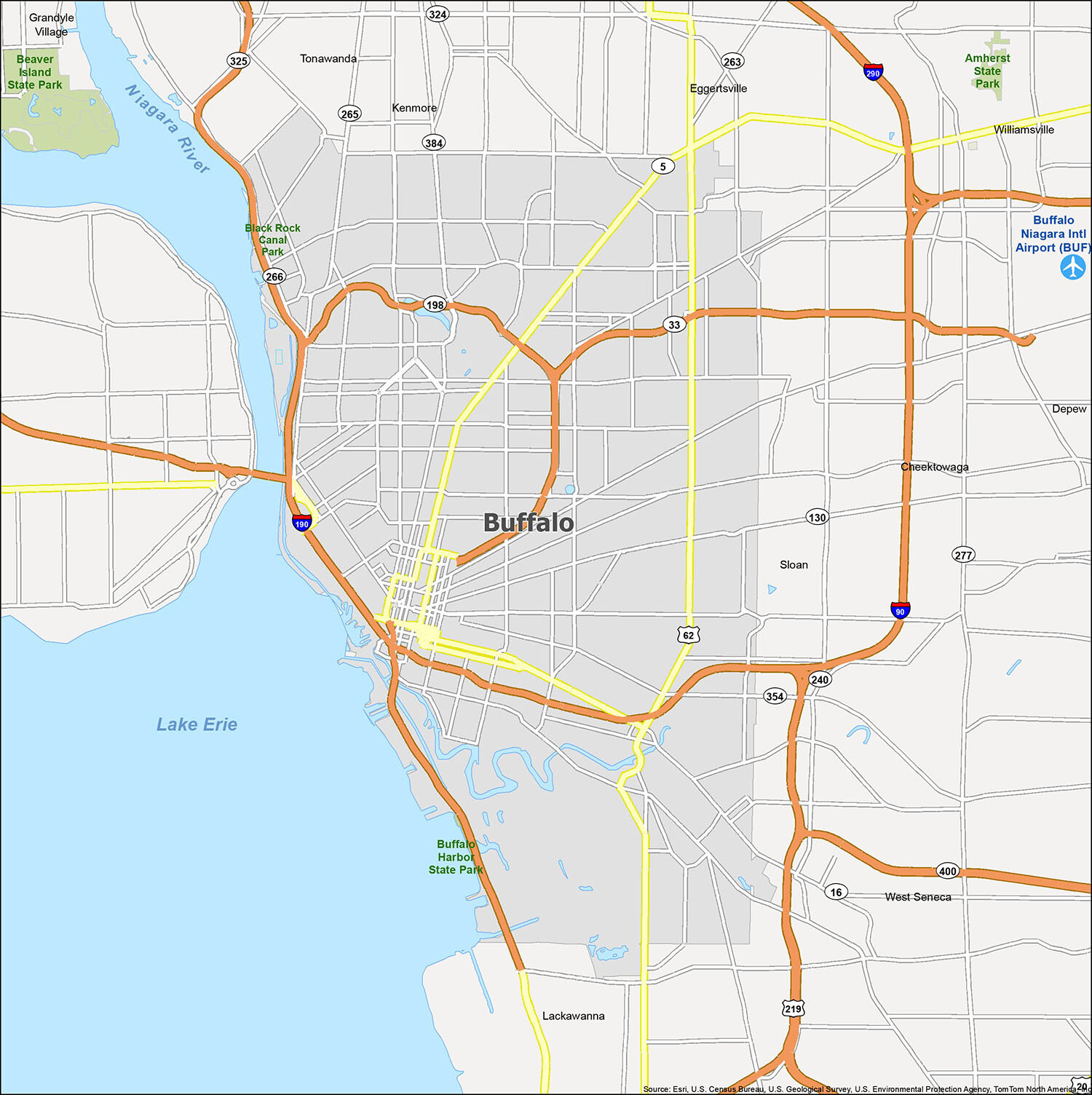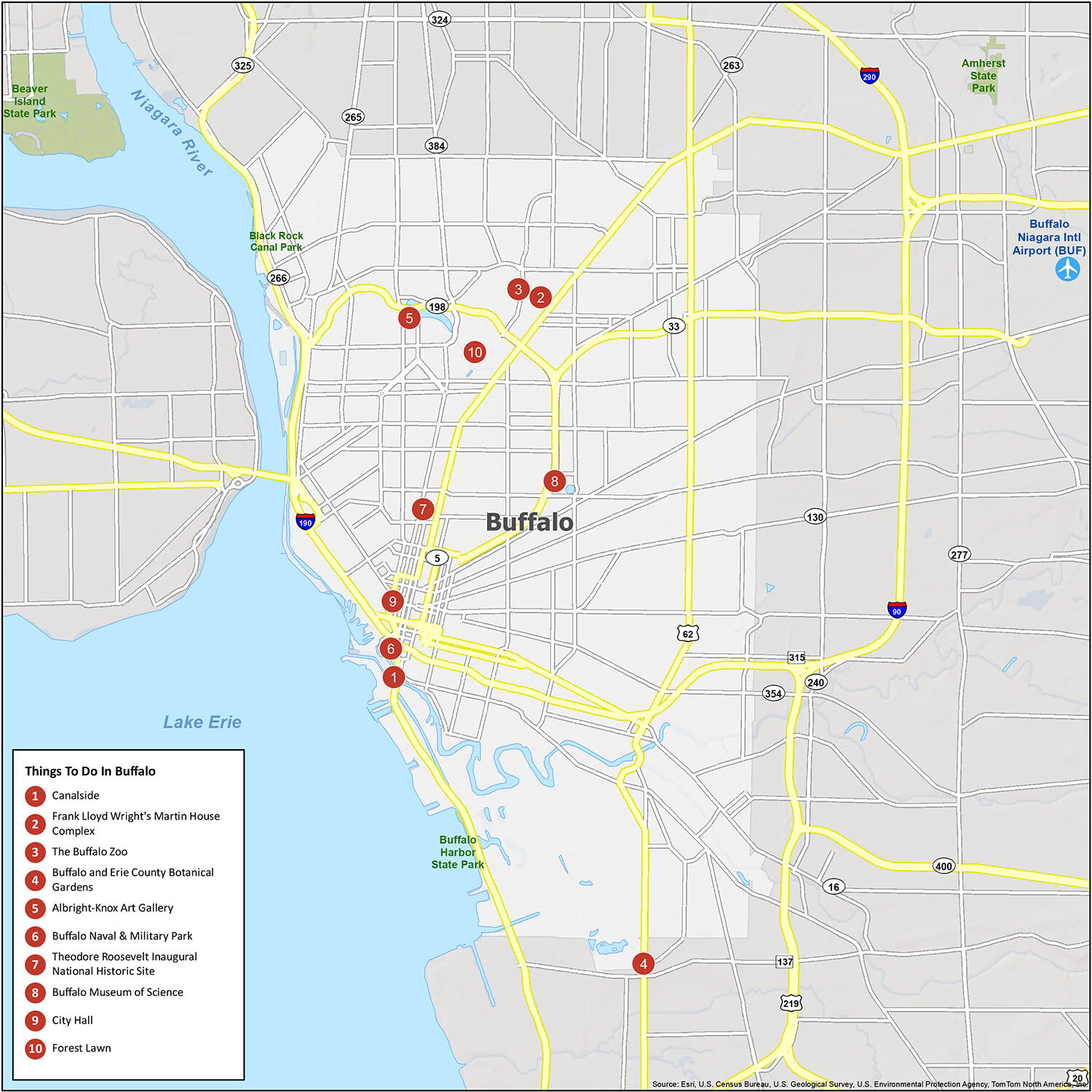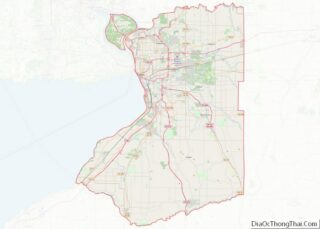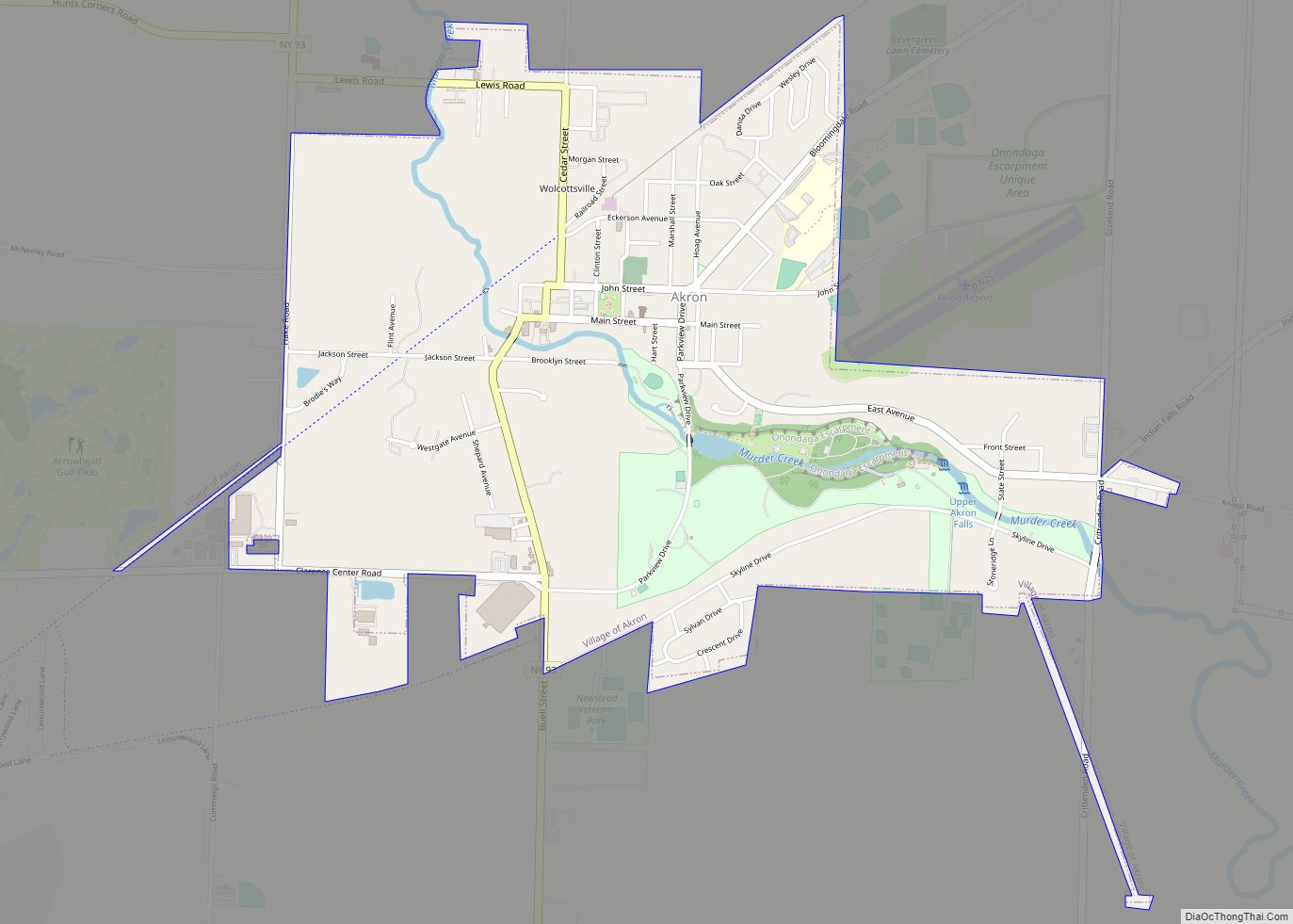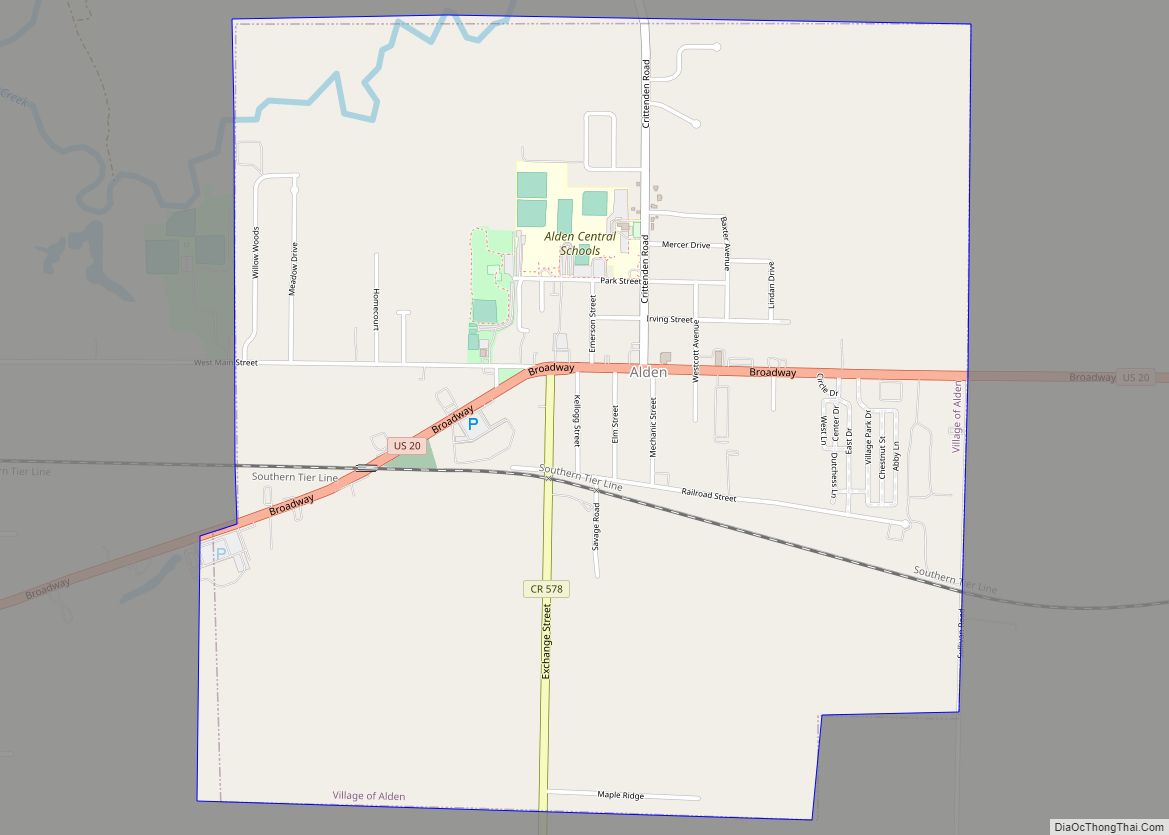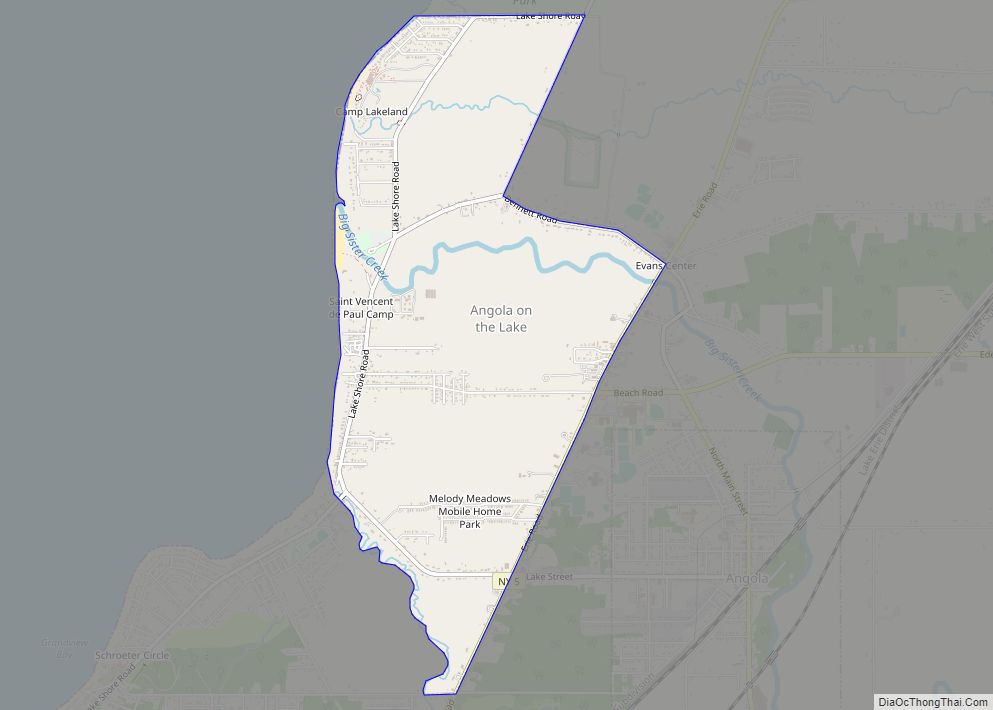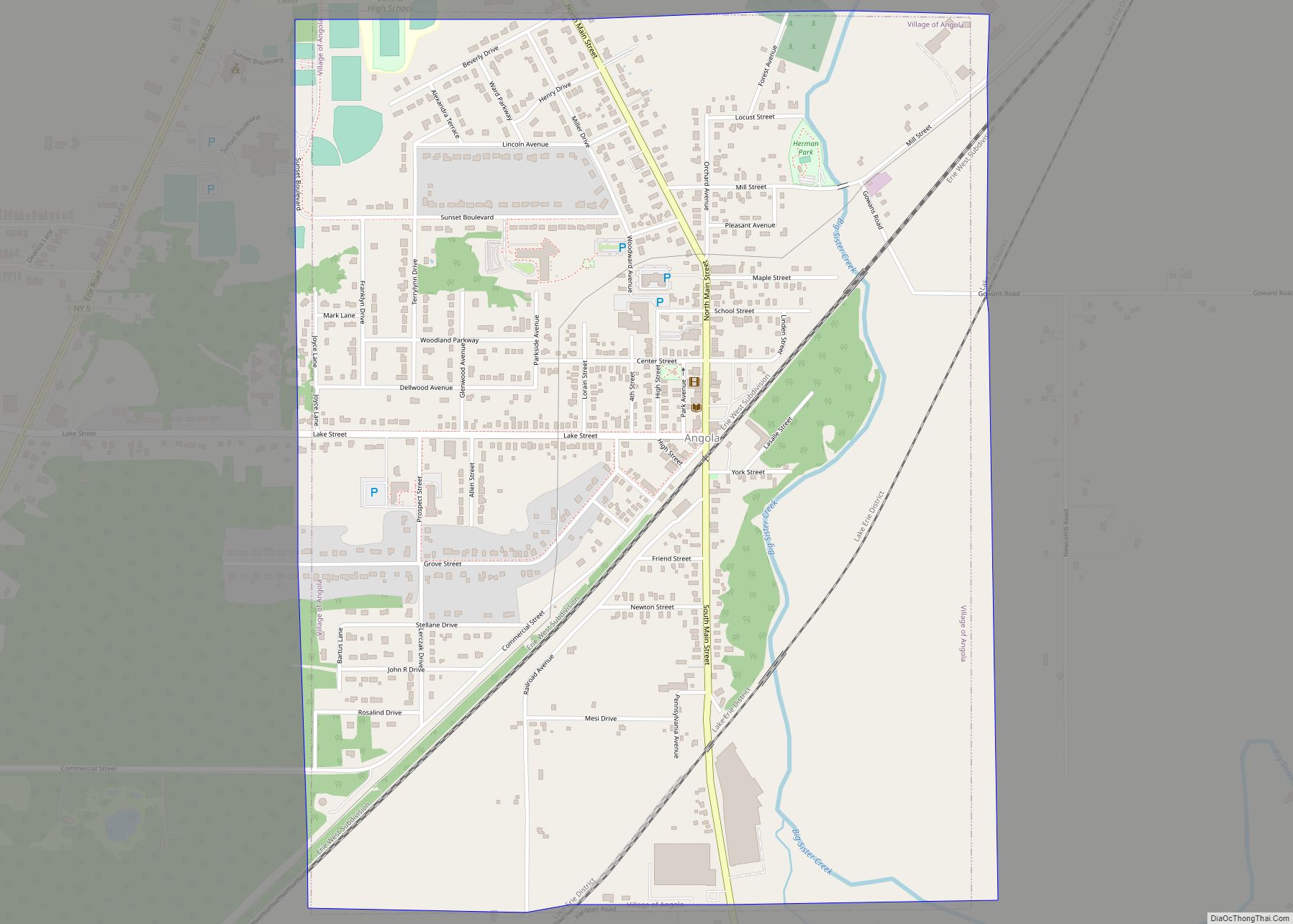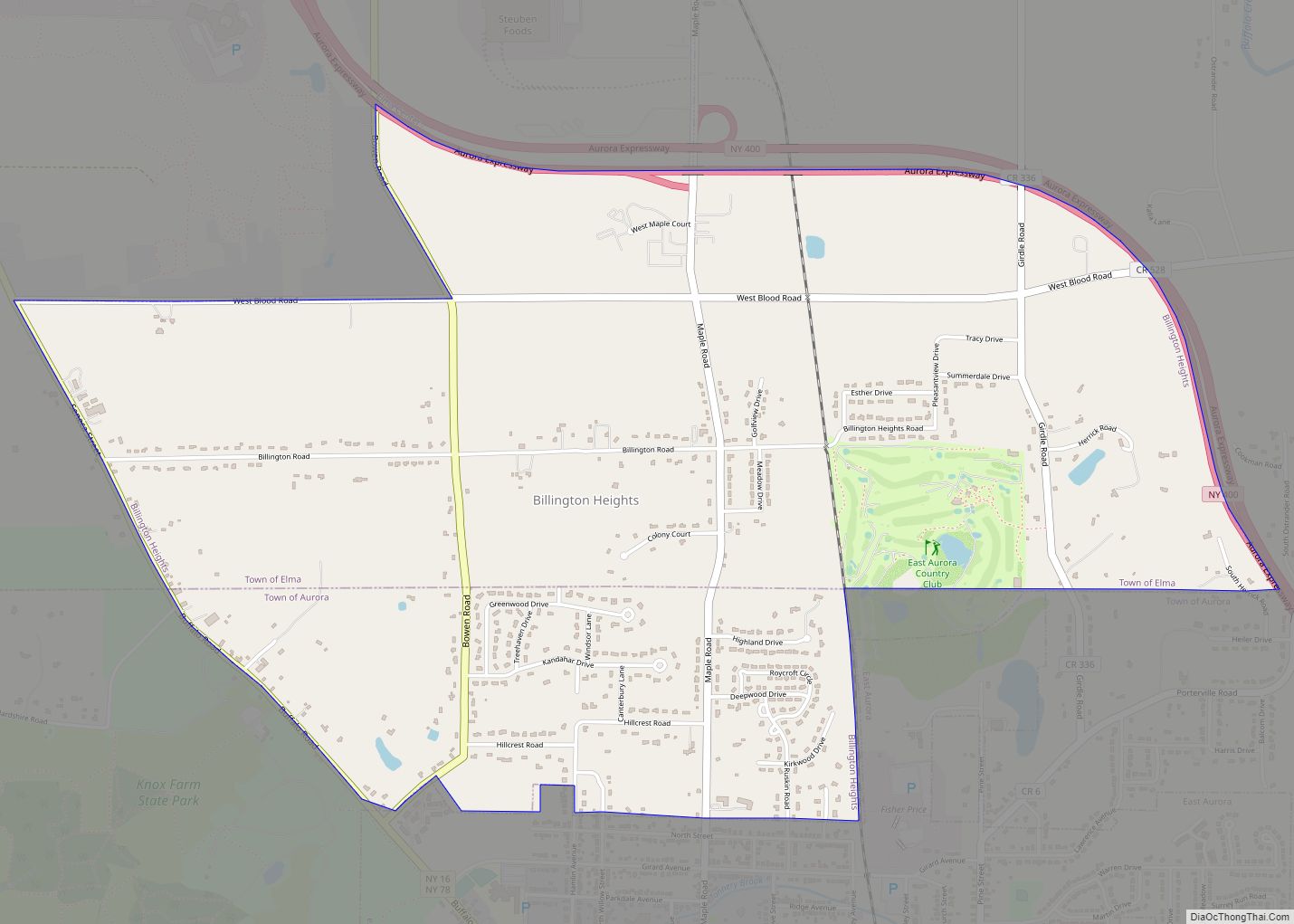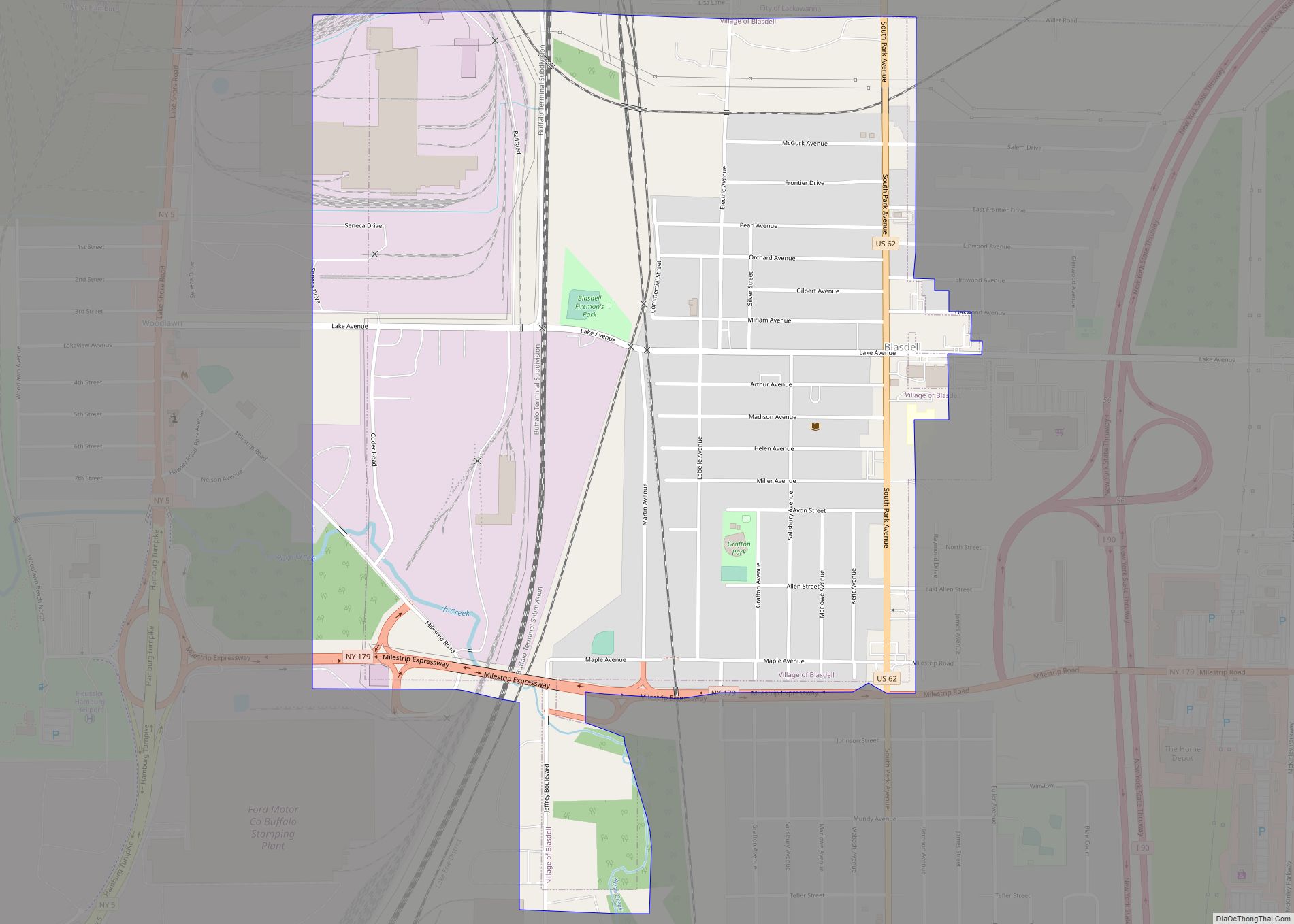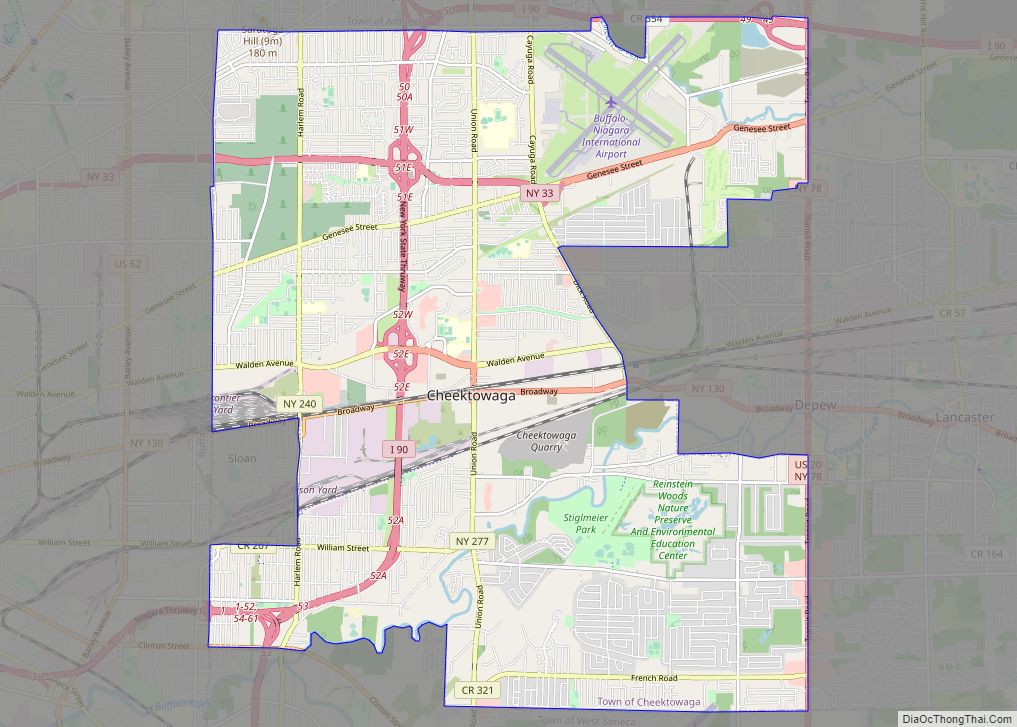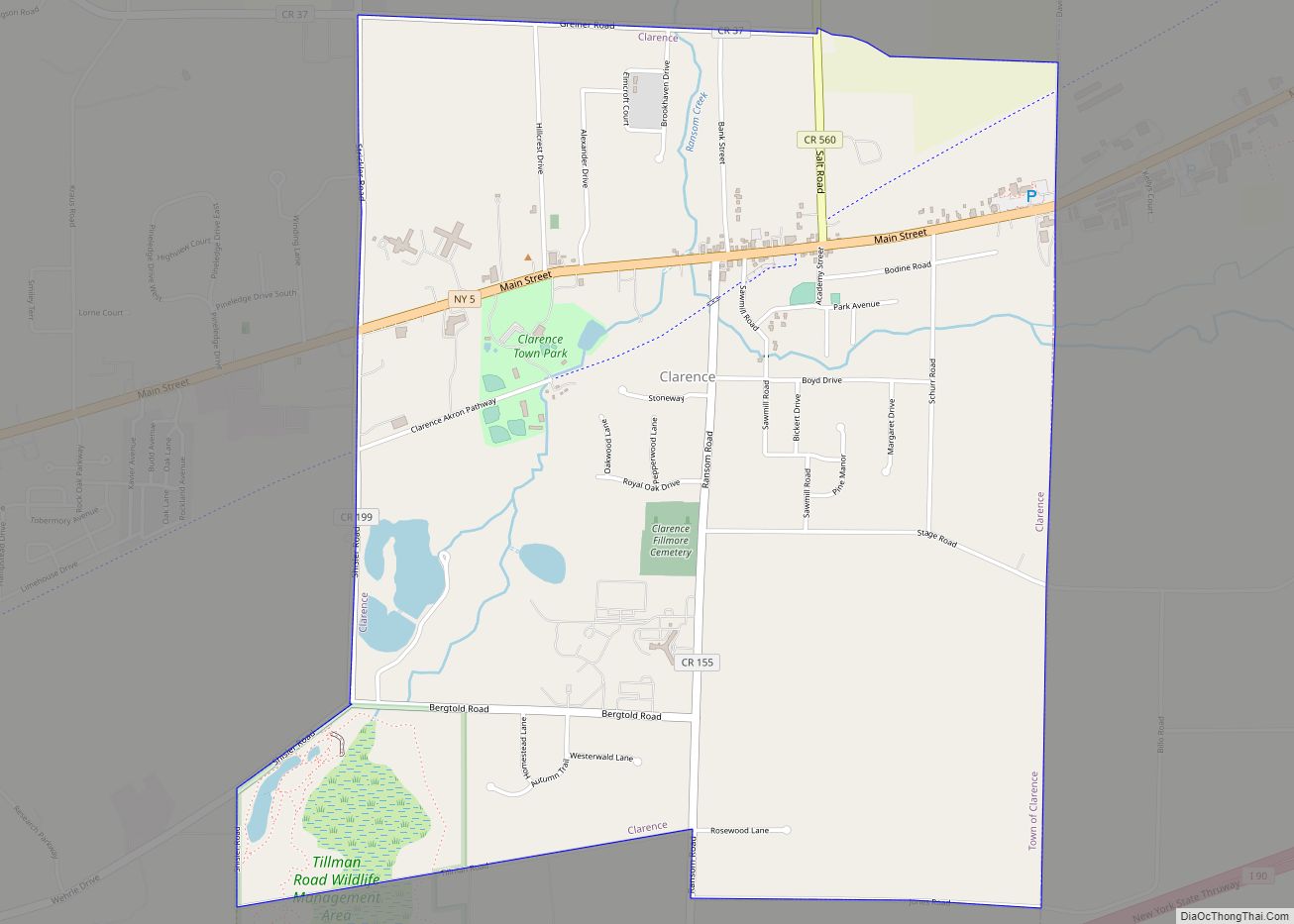Buffalo is the second-largest city in the U.S. state of New York (after New York City) and the seat of Erie County. It lies in Western New York, at the eastern end of Lake Erie, at the head of the Niagara River, on the United States border with Canada. With a population of 278,349 according to the 2020 census, Buffalo is the 78th-largest city in the United States. Buffalo and the city of Niagara Falls together make up the two-county Buffalo–Niagara Falls Metropolitan Statistical Area (MSA), which had an estimated population of 1.1 million in 2020, making it the 49th largest MSA in the United States.
Before the 17th century, the region was inhabited by nomadic Paleo-Indians who were succeeded by the Neutral, Erie, and Iroquois nations. In the early 17th century, the French began to explore the region. In the 18th century, Iroquois land surrounding Buffalo Creek was ceded through the Holland Land Purchase, and a small village was established at its headwaters. In 1825, after its harbor was improved, Buffalo was selected as the terminus of the Erie Canal, which led to its incorporation in 1832. The canal stimulated its growth as the primary inland port between the Great Lakes and the Atlantic Ocean. Transshipment made Buffalo the world’s largest grain port of that era. After the coming of railroads greatly reduced the canal’s importance, the city became the second-largest railway hub (after Chicago). During the mid-19th century, Buffalo transitioned to manufacturing, which came to be dominated by steel production. Later, deindustrialization and the opening of the St. Lawrence Seaway saw the city’s economy decline and diversify. It developed its service industries, such as health care, retail, tourism, logistics, and education, while retaining some manufacturing. In 2019, the gross domestic product of the Buffalo–Niagara Falls MSA was $53 billion.
The city’s cultural landmarks include the oldest urban parks system in the United States, the Albright–Knox Art Gallery, the Buffalo Philharmonic Orchestra, Shea’s Performing Arts Center, the Buffalo Museum of Science, and several annual festivals. Its educational institutions include the University at Buffalo, Buffalo State University, Canisius College, D’Youville University and Medaille College. Buffalo is also known for its winter weather, Buffalo wings, and three major-league sports teams: the National Football League’s Buffalo Bills, the National Hockey League’s Buffalo Sabres and the National Lacrosse League’s Buffalo Bandits.
| Name: | Buffalo city |
|---|---|
| LSAD Code: | 25 |
| LSAD Description: | city (suffix) |
| State: | New York |
| County: | Erie County |
| Founded: | 1801; 222 years ago (1801) |
| Elevation: | 600 ft (200 m) |
| Land Area: | 40.38 sq mi (104.58 km²) |
| Water Area: | 12.10 sq mi (31.34 km²) |
| Population Density: | 6,893.41/sq mi (2,661.58/km²) |
| ZIP code: | 142XX |
| Area code: | 716 |
| FIPS code: | 3611000 |
| GNISfeature ID: | 0973345 |
| Website: | www.buffalony.gov |
Discover the city of Buffalo with our map collection! From highways and roads to landmarks, neighborhoods, and major attractions, our collection of maps will help you navigate the city like a pro.
We also provide an interactive map with major sightseeing destinations in the city. It’s easy to explore the city’s active nightlife, enjoy the snow in the winter, and taste the famous Buffalo wings. Plus, it’s just a short drive to the magnificent Niagara Falls.
Overall, Buffalo is an incredible city with a vibrant culture and unique local style. With our collection of maps, you can easily explore the city and discover its wonders!
Online Interactive Map
Click on ![]() to view map in "full screen" mode.
to view map in "full screen" mode.
With just a few clicks, you will be able to learn about the neighborhoods and find your way around with this interactive map of Buffalo. It includes all major areas and interesting tourist sites in Buffalo. For instance, you can locate the nearest attractions, restaurants, and shopping venues. This map also displays everything from hotels, fast food restaurants, gas stations, and more.
Buffalo location map. Where is Buffalo city?
History
Pre-Columbian era to European exploration
Before the arrival of Europeans, nomadic Paleo-Indians inhabited the western New York region from the 8th millennium BC. The Woodland period began around 1000 BC, marked by the rise of the Iroquois Confederacy and the spread of its tribes throughout the state. Seventeenth-century Jesuit missionaries were the first Europeans to visit the area.
During French exploration of the region in 1620, the region was sparsely populated and occupied by the agrarian Erie people in the south and the Wenrohronon (Wenro) of the Neutral Nation in the north. The Neutral grew tobacco and hemp to trade with the Iroquois, who traded furs with the French for European goods. The tribes used animal- and war paths to travel and move goods across what today is New York State. (Centuries later, these same paths were gradually improved, then paved, then developed into major modern roads.) During the Beaver Wars in the mid-17th century the Senecas partly wiped out and partly absorbed the Erie and Neutrals in the region. Native Americans did not settle along Buffalo Creek permanently until 1780, when displaced Senecas were relocated from Fort Niagara.
Louis Hennepin and Sieur de La Salle explored the upper Niagara and Ontario regions in the late 1670s. In 1679, La Salle’s ship, Le Griffon, became the first to sail above Niagara Falls near Cayuga Creek. Baron de Lahontan visited the site of Buffalo in 1687. A small French settlement along Buffalo Creek lasted for only a year (1758). After the French and Indian War, the region was ruled by Britain. After the American Revolution, the Province of New York—now a U.S. state—began westward expansion, looking for arable land by following the Iroquois.
New York and Massachusetts were vying for the territory which included Buffalo, and Massachusetts had the right to purchase all but a one-mile-(1600-meter)-wide portion of land. The rights to the Massachusetts territories were sold to Robert Morris in 1791. Despite objections from Seneca chief Red Jacket, Morris brokered a deal between fellow chief Cornplanter and the Dutch dummy corporation Holland Land Company. The Holland Land Purchase gave the Senecas three reservations, and the Holland Land Company received 4,000,000 acres (16,000 km) for about thirty-three cents per acre.
Permanent white settlers along the creek were prisoners captured during the Revolutionary War. Early landowners were Iroquois interpreter Captain William Johnston, former enslaved man Joseph “Black Joe” Hodges and Cornelius Winney, a Dutch trader who arrived in 1789. As a result of the war, in which the Iroquois sided with the British Army, Iroquois territory was gradually reduced in the late 1700s by European settlers through successive statewide treaties which included the Treaty of Fort Stanwix (1784) and the First Treaty of Buffalo Creek (1788). The Iroquois were moved onto reservations, including Buffalo Creek. By the end of the 18th century, only 338 sq mi (216,000 acres; 880 km; 88,000 ha) of reservations remained.
After the Treaty of Big Tree removed Iroquois title to lands west of the Genesee River in 1797, Joseph Ellicott surveyed land at the mouth of Buffalo Creek. In the middle of the village was an intersection of eight streets at present-day Niagara Square. Originally named New Amsterdam, its name was soon changed to Buffalo.
Erie Canal, grain and commerce
The village of Buffalo was named for Buffalo Creek. British military engineer John Montresor referred to “Buffalo Creek” in his 1764 journal, the earliest recorded appearance of the name. A road to Pennsylvania from Buffalo was built in 1802 for migrants traveling to the Connecticut Western Reserve in Ohio. Before an east–west turnpike across the state was completed, traveling from Albany to Buffalo would take a week; a trip from nearby Williamsville to Batavia could take over three days.
British forces burned Buffalo and the northwestern village of Black Rock in 1813. The battle and subsequent fire was in response to the destruction of Niagara-on-the-Lake by American forces and other skirmishes during the War of 1812. Rebuilding was swift, completed in 1815. As a remote outpost, village residents hoped that the proposed Erie Canal would bring prosperity to the area. To accomplish this, Buffalo’s harbor was expanded with the help of Samuel Wilkeson; it was selected as the canal’s terminus over the rival Black Rock. It opened in 1825, ushering in commerce, manufacturing and hydropower. By the following year, the 130 sq mi (340 km) Buffalo Creek Reservation (at the western border of the village) was transferred to Buffalo. Buffalo was incorporated as a city in 1832. During the 1830s, businessman Benjamin Rathbun significantly expanded its business district. The city doubled in size from 1845 to 1855. Almost two-thirds of the city’s population was foreign-born, largely a mix of unskilled (or educated) Irish and German Catholics.
Fugitive slaves made their way north to Buffalo during the 1840s. Buffalo was a terminus of the Underground Railroad, with many free blacks crossing the Niagara River to Fort Erie, Ontario; others remained in Buffalo. During this time, Buffalo’s port continued to develop. Passenger and commercial traffic expanded, leading to the creation of feeder canals and the expansion of the city’s harbor. Unloading grain in Buffalo was a laborious job, and grain handlers working on lake freighters would make $1.50 a day in a six-day work week. Local inventor Joseph Dart and engineer Robert Dunbar created the grain elevator in 1843, adapting the steam-powered elevator. Dart’s Elevator initially processed one thousand bushels per hour, speeding global distribution to consumers. Buffalo was the transshipment hub of the Great Lakes, and weather, maritime and political events in other Great Lakes cities had a direct impact on the city’s economy. In addition to grain, Buffalo’s primary imports included agricultural products from the Midwest (meat, whiskey, lumber and tobacco), and its exports included leather, ships and iron products. The mid-19th century saw the rise of new manufacturing capabilities, particularly with iron.
By the 1860s, many railroads terminated in Buffalo; they included the Buffalo, Bradford and Pittsburgh Railroad, Buffalo and Erie Railroad, the New York Central Railroad, and the Lehigh Valley Railroad. During this time, Buffalo controlled one-quarter of all shipping traffic on Lake Erie. After the Civil War, canal traffic began to drop as railroads expanded into Buffalo. Unionization began to take hold in the late 19th century, highlighted by railroad strikes in 1877 and 1892.
Steel, challenges, and the modern era
At the start of the 20th century, Buffalo was the world’s leading grain port and a national flour-milling hub. Local mills were among the first to benefit from hydroelectricity generated by the Niagara River. Buffalo hosted the 1901 Pan-American Exposition after the Spanish–American War, showcasing the nation’s advances in art, architecture, and electricity. Its centerpiece was the Electric Tower, with over two million light bulbs, but some exhibits were jingoistic and racially charged. At the exposition, President William McKinley was assassinated by anarchist Leon Czolgosz. When McKinley died, Theodore Roosevelt was sworn in at the Wilcox Mansion in Buffalo.
Attorney John Milburn and local industrialists and convinced the Lackawanna Iron and Steel Company to relocate from Scranton, Pennsylvania to the town of West Seneca in 1904. Employment was competitive, with many Eastern Europeans and Scrantonians vying for jobs. From the late 19th century to the 1920s, mergers and acquisitions led to distant ownership of local companies; this had a negative effect on the city’s economy. Examples include the acquisition of Lackawanna Steel by Bethlehem Steel and, later, the relocation of Curtiss-Wright in the 1940s. The Great Depression saw severe unemployment, especially among the working class. New Deal relief programs operated in full force, and the city became a stronghold of labor unions and the Democratic Party.
During World War II, Buffalo regained its manufacturing strength as military contracts enabled the city to manufacture steel, chemicals, aircraft, trucks and ammunition. The 15th-most-populous US city in 1950, Buffalo’s economy relied almost entirely on manufacturing; eighty percent of area jobs were in the sector. The city also had over a dozen railway terminals, as railroads remained a significant industry.
The St. Lawrence Seaway was proposed in the 19th century as a faster shipping route to Europe, and later as part of a bi-national hydroelectric project with Canada. Its combination with an expanded Welland Canal led to a grim outlook for Buffalo’s economy. After its 1959 opening, the city’s port and barge canal became largely irrelevant. Shipbuilding in Buffalo wound down in the 1960s due to reduced waterfront activity, ending an industry which had been part of the city’s economy since 1812. Downsizing of the steel mills was attributed to the threat of higher wages and unionization efforts. Racial tensions culminated in riots in 1967. Suburbanization led to the selection of the town of Amherst for the new University at Buffalo campus by 1970. Unwilling to modernize its plant, Bethlehem Steel began cutting thousands of jobs in Lackawanna during the mid-1970s before closing it in 1983. The region lost at least 70,000 jobs between 1970 and 1984. Like much of the Rust Belt, Buffalo has focused on recovering from the effects of late-20th-century deindustrialization.
Buffalo Road Map
Enjoy this beautiful printable map of Buffalo, New York that shows major highways and roads like 1-90 and I-190. It’s home to the world-famous Niagara Falls and many recreational activities. If you’re looking for a day trip or just a weekend getaway, Buffalo has something for everyone. Plus, it’s only 370 miles (500 km) away from New York City. Make sure to print this road map to better enjoy your visit to Buffalo, New York.
Interstate: I-190
US Highways: 5, 16, 33, 62, 129, 130, 189, 190, 198, 201, 266, 307, 354, 384, 550
Major Roads: Baird Dr, Bailey Ave, Berwyn Ave, Broadway St, Burlington Ave, Busti Ave, Church St, Clinton St, Court St, Delaware Ave, Division St, Elm St, Elmwood Ave, Lafayette Sq, Lower Terrace St, Main St, Niagara St, Nottingham Ter, Park Ave, Pine St, Oak St, Peace Bridge Connector, Porter Ave, Sheridan Ter, Tupper St, Virginia St, William St
Buffalo, New York is home to an estimated 250,000 people, making it the second-largest city in the state. The city is bordered by the Niagara River and Lake Erie, and the map shows the different neighborhoods, villages, parks, and Buffalo Niagara International Airport (BUF) that make up the area. The surrounding villages include Depew, Kenmore, Sloan, and Williamsville, while the census-designated places are Cheektowaga, Eggertsville, Grandyle Village, Tonawanda, and West Seneca.
10 things to do in Buffalo city
This Buffalo map is the perfect guide for anyone looking to explore the city. Situated on the shores of Lake Erie, Buffalo has been able to gain momentum for its growing economy by building up its strategic location on the main waterway of America’s inland waterways. From Canalside to the Buffalo Zoo, this map will help you find some of the city’s best attractions. Visit the Frank Lloyd Wright’s Martin House Complex, the Buffalo and Erie County Botanical Gardens, the Albright-Knox Art Gallery, the Buffalo Naval & Military Park, the Theodore Roosevelt Inaugural National Historic Site, the Buffalo Museum of Science, City Hall and Forest Lawn.
This Buffalo map is the perfect guide for anyone looking to explore the city. From Canalside to the Buffalo Zoo, this map will help you find some of the city’s best attractions. Take a stroll along the shores of Lake Erie and visit the Frank Lloyd Wright’s Martin House Complex, the Buffalo and Erie County Botanical Gardens, the Albright-Knox Art Gallery, the Buffalo Naval & Military Park, the Theodore Roosevelt Inaugural National Historic Site, the Buffalo Museum of Science, City Hall and Forest Lawn.
Buffalo city Satellite Map
Geography
Topography
Buffalo is on the eastern end of Lake Erie opposite Fort Erie, Ontario. It is at the head of the Niagara River, which flows north over Niagara Falls into Lake Ontario.
The Buffalo metropolitan area is on the Erie/Ontario Lake Plain of the Eastern Great Lakes Lowlands, a narrow plain extending east to Utica, New York. The city is generally flat, except for elevation changes in the University Heights and Fruit Belt neighborhoods. The Southtowns are hillier, leading to the Cattaraugus Hills in the Appalachian Upland. Several types of shale, limestone and lagerstätten are prevalent in Buffalo and its surrounding area, lining their stream beds.
According to Fox Weather, Buffalo is one of the top five snowiest large cities in the country, receiving, on average, 95 inches of snow annually.
Although the city has not experienced any recent or significant earthquakes, Buffalo is in the Southern Great Lakes Seismic Zone (part of the Great Lakes tectonic zone). Buffalo has four channels within its boundaries: the Niagara River, Buffalo River (and Creek), Scajaquada Creek, and the Black Rock Canal, adjacent to the Niagara River. The city’s Bureau of Forestry maintains a database of over seventy thousand trees.
According to the United States Census Bureau, Buffalo has an area of 52.5 sq mi (136 km); 40.38 sq mi (104.6 km) is land, and the rest is water. The city’s total area is 22.66 percent water. In 2010, its population density was 6,470.6 per square mile.
Cityscape
Buffalo’s architecture is diverse, with a collection of 19th- and 20th-century buildings. Downtown Buffalo landmarks include Louis Sullivan’s Guaranty Building, an early skyscraper; the Ellicott Square Building, once one of the largest of its kind in the world; the Art Deco Buffalo City Hall and the McKinley Monument, and the Electric Tower. Beyond downtown, the Buffalo Central Terminal was built in the Broadway-Fillmore neighborhood in 1929; the Richardson Olmsted Complex, built in 1881, was an insane asylum until its closure in the 1970s. Urban renewal from the 1950s to the 1970s spawned the Brutalist-style Buffalo City Court Building and Seneca One Tower, the city’s tallest building. In the city’s Parkside neighborhood, the Darwin D. Martin House was designed by Frank Lloyd Wright in his Prairie School style. Since 2016, Washington DC real estate developer Douglas Jemal has been acquiring, and redeveloping iconic properties throughout the city.
Neighborhoods
According to Mark Goldman, the city has a “tradition of separate and independent settlements”. The boundaries of Buffalo’s neighborhoods have changed over time. The city is divided into five districts, each containing several neighborhoods, for a total of thirty-five neighborhoods. Main Street divides Buffalo’s east and west sides, and the west side was fully developed earlier. This division is seen in architectural styles, street names, neighborhood and district boundaries, demographics, and socioeconomic conditions; Buffalo’s West Side is generally more affluent than its East Side.
Several neighborhoods in Buffalo have had increased investment since the 1990s, beginning with the Elmwood Village. The 2002 redevelopment of the Larkin Terminal Warehouse led to the creation of Larkinville, home to several mixed-use projects and anchored by corporate offices. Downtown Buffalo and its central business district (CBD) had a 10.6-percent increase in residents from 2010 to 2017, as over 1,061 housing units became available; the Seneca One Tower was redeveloped in 2020. Other revitalized areas include Chandler Street, in the Grant-Amherst neighborhood, and Hertel Avenue in Parkside.
The Buffalo Common Council adopted its Green Code in 2017, replacing zoning regulations which were over sixty years old. Its emphasis on regulations promoting pedestrian safety and mixed land use received an award at the 2019 Congress for the New Urbanism conference.
Climate
Buffalo has a humid continental climate (Köppen: Dfb/Dfa), and temperatures have been warming with the rest of the US. Lake-effect snow is characteristic of Buffalo winters, with snow bands (producing intense snowfall in the city and surrounding area) depending on wind direction off Lake Erie. However, Buffalo is rarely the snowiest city in the state. The Blizzard of 1977 resulted from a combination of high winds and snow which accumulated on land and on the frozen Lake Erie. Although snow does not typically impair the city’s operation, it can cause significant damage in autumn (as the October 2006 storm did). In November 2014 (called “Snowvember”), the region had a record-breaking storm which produced over 5+1⁄2 ft (66 in; 170 cm) of snow. Buffalo’s lowest recorded temperature was −20 °F (−29 °C), which occurred twice: on February 9, 1934, and February 2, 1961.
Although the city’s summers are drier and sunnier than other cities in the northeastern United States, its vegetation receives enough precipitation to remain hydrated. Buffalo summers are characterized by abundant sunshine, with moderate humidity and temperatures; the city benefits from cool, southwestern Lake Erie summer breezes which temper warmer temperatures. Temperatures rise above 90 °F (32.2 °C) an average of three times a year. No official recording of 100 °F (37.8 °C) or more has occurred to date, with a maximum temperature of 99 °F (37 °C) reached on August 27, 1948. Rainfall is moderate, typically falling at night, and cooler lake temperatures hinder storm development in July. August is usually rainier and muggier, as the warmer lake loses its temperature-controlling ability.
See also
Map of New York State and its subdivision:- Albany
- Allegany
- Bronx
- Broome
- Cattaraugus
- Cayuga
- Chautauqua
- Chemung
- Chenango
- Clinton
- Columbia
- Cortland
- Delaware
- Dutchess
- Erie
- Essex
- Franklin
- Fulton
- Genesee
- Greene
- Hamilton
- Herkimer
- Jefferson
- Kings
- Lake Ontario
- Lewis
- Livingston
- Madison
- Monroe
- Montgomery
- Nassau
- New York
- Niagara
- Oneida
- Onondaga
- Ontario
- Orange
- Orleans
- Oswego
- Otsego
- Putnam
- Queens
- Rensselaer
- Richmond
- Rockland
- Saint Lawrence
- Saratoga
- Schenectady
- Schoharie
- Schuyler
- Seneca
- Steuben
- Suffolk
- Sullivan
- Tioga
- Tompkins
- Ulster
- Warren
- Washington
- Wayne
- Westchester
- Wyoming
- Yates
- Alabama
- Alaska
- Arizona
- Arkansas
- California
- Colorado
- Connecticut
- Delaware
- District of Columbia
- Florida
- Georgia
- Hawaii
- Idaho
- Illinois
- Indiana
- Iowa
- Kansas
- Kentucky
- Louisiana
- Maine
- Maryland
- Massachusetts
- Michigan
- Minnesota
- Mississippi
- Missouri
- Montana
- Nebraska
- Nevada
- New Hampshire
- New Jersey
- New Mexico
- New York
- North Carolina
- North Dakota
- Ohio
- Oklahoma
- Oregon
- Pennsylvania
- Rhode Island
- South Carolina
- South Dakota
- Tennessee
- Texas
- Utah
- Vermont
- Virginia
- Washington
- West Virginia
- Wisconsin
- Wyoming
